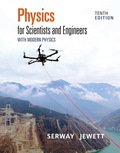
Concept explainers
(a)
The constant friction force for the last
(a)
Answer to Problem 25AP
The constant friction force for the last
Explanation of Solution
The mass of the empty car is
Write the formula to calculate the energy by equation of motion
Here,
The formula of initial kinetic energy is,
Substitute
The formula of kinetic energy at final point
Substitute
The formula of the potential energy at start
Substitute
The formula of the potential energy at final point
Substitute
The formula of the energy wasted due to friction
Substitute
Substitute
Conclusion:
Substitute
Therefore, the constant friction force for the last
(b)
The highest speed reached by the car.
(b)
Answer to Problem 25AP
The highest speed reached by the car is
Explanation of Solution
The formula of kinetic energy at final point
The body is at the lowest point so the resistive force is taken upto that point only.
The formula of the energy wasted due to friction
Substitute
Write the formula to calculate the final velocity from equation (1) can be written as,
Conclusion:
Substitute
Therefore, the highest speed reached by the car is
(c)
The new values of friction force and highest speed when the weight is
(c)
Answer to Problem 25AP
The new value of friction force is
Explanation of Solution
The mass of the empty car is
The Write the formula to calculate the
Substitute
To calculate the final velocity the equation (2)
Substitute
Conclusion:
Therefore, the new value of friction force is
(d)
The depth of the underground part of the ride.
(d)
Answer to Problem 25AP
The depth of the underground part of the ride is
Explanation of Solution
Consider
The formula of the potential energy at start
Substitute
The Write the formula to calculate the depth
Conclusion:
Substitute
Therefore, the depth of the underground part of the ride is
(e)
The depth of the underground provided is feasible or not.
(e)
Answer to Problem 25AP
No, the depth of the underground provided is not feasible.
Explanation of Solution
No the depth of the underground tunnel provided is not feasible as the total length covered by the car is increased due to which the loss of energy due to friction is increased a lot as compared to the case when the underground path was not there. The non-conventional forces on the car are increased due to the depth provided as the friction in the path of later
Conclusion:
Therefore, the depth of the underground provided is not feasible.
Want to see more full solutions like this?
Chapter 8 Solutions
EBK PHYSICS FOR SCIENTISTS AND ENGINEER
- Can someone help mearrow_forward3. Four identical small masses are connected in a flat perfect square. Rank the relative rotational inertias (IA, IB, IC) about the three axes of rotation shown. Axes A and B are in the plane of the square, and axis C is perpendicular to the plane, through mass m1. ΙΑ IB m2 m1 m3 Ic m4 (a) IAarrow_forwardConsider the circuit shown in the figure below. (Assume L = 5.20 m and R2 = 440 Ω.) (a) When the switch is in position a, for what value of R1 will the circuit have a time constant of 15.4 µs? (b) What is the current in the inductor at the instant the switch is thrown to position b?arrow_forwardCan someone helparrow_forwardCan someone help mearrow_forwardA particle in a box between x=0 and x=6 has the wavefunction Psi(x)=A sin(2πx). How muchenergy is required for the electron to make a transition to Psi(x)= A’ sin(7π x/3). Draw anapproximate graph for the wavefunction. Find A and A'arrow_forwardA proton is moving with 10^8 m/s speed. Find the De Broglie wavelength associated with theproton and the frequency of that wave.arrow_forwardFind the wavelength of the photon if a (Li--) electron makes a transition from n=4 to n=3. Findthe Bohr radius for each state.arrow_forwardA photon with wavelength 3000 nm hits a stationary electron. After the collision electron isscattered to 60 degrees. Find the wavelength and frequency of the scattered photon.arrow_forwardA metal has threshold frequency 10^15. Calculate the maximum kinetic energy of the ejectedelectron if a laser beam with wavelength 1.5 10^-7 m is projected on the metal.arrow_forwardDetermine the direction of the vector V, B, or ♬ that is missing from the pair of vectors shown in each scenario. Here, u is the velocity vector of a moving positive charge, B is a constant and uniform magnetic field, and F is the resulting force on the moving charge. 1. 2. 3. B OB F 4. ↑F F 5. 怔 ↑ ↑F Answer Bank 6. ↑ TE Farrow_forwardTwo point charges (+9.80 nC and -9.80 nC) are located 8.00 cm apart. Let U=0 when all of the charges are separated by infinite distances. What is the potential energy if a third point charge q=-4.20 nC is placed at point b? 8.00 cm 8.00 cm 4.00 +4.00 +4.00- cm cm cm HJarrow_forwardarrow_back_iosSEE MORE QUESTIONSarrow_forward_ios
 Physics for Scientists and Engineers: Foundations...PhysicsISBN:9781133939146Author:Katz, Debora M.Publisher:Cengage Learning
Physics for Scientists and Engineers: Foundations...PhysicsISBN:9781133939146Author:Katz, Debora M.Publisher:Cengage Learning College PhysicsPhysicsISBN:9781285737027Author:Raymond A. Serway, Chris VuillePublisher:Cengage Learning
College PhysicsPhysicsISBN:9781285737027Author:Raymond A. Serway, Chris VuillePublisher:Cengage Learning Principles of Physics: A Calculus-Based TextPhysicsISBN:9781133104261Author:Raymond A. Serway, John W. JewettPublisher:Cengage Learning
Principles of Physics: A Calculus-Based TextPhysicsISBN:9781133104261Author:Raymond A. Serway, John W. JewettPublisher:Cengage Learning Physics for Scientists and Engineers with Modern ...PhysicsISBN:9781337553292Author:Raymond A. Serway, John W. JewettPublisher:Cengage Learning
Physics for Scientists and Engineers with Modern ...PhysicsISBN:9781337553292Author:Raymond A. Serway, John W. JewettPublisher:Cengage Learning Physics for Scientists and EngineersPhysicsISBN:9781337553278Author:Raymond A. Serway, John W. JewettPublisher:Cengage Learning
Physics for Scientists and EngineersPhysicsISBN:9781337553278Author:Raymond A. Serway, John W. JewettPublisher:Cengage Learning Physics for Scientists and Engineers, Technology ...PhysicsISBN:9781305116399Author:Raymond A. Serway, John W. JewettPublisher:Cengage Learning
Physics for Scientists and Engineers, Technology ...PhysicsISBN:9781305116399Author:Raymond A. Serway, John W. JewettPublisher:Cengage Learning





